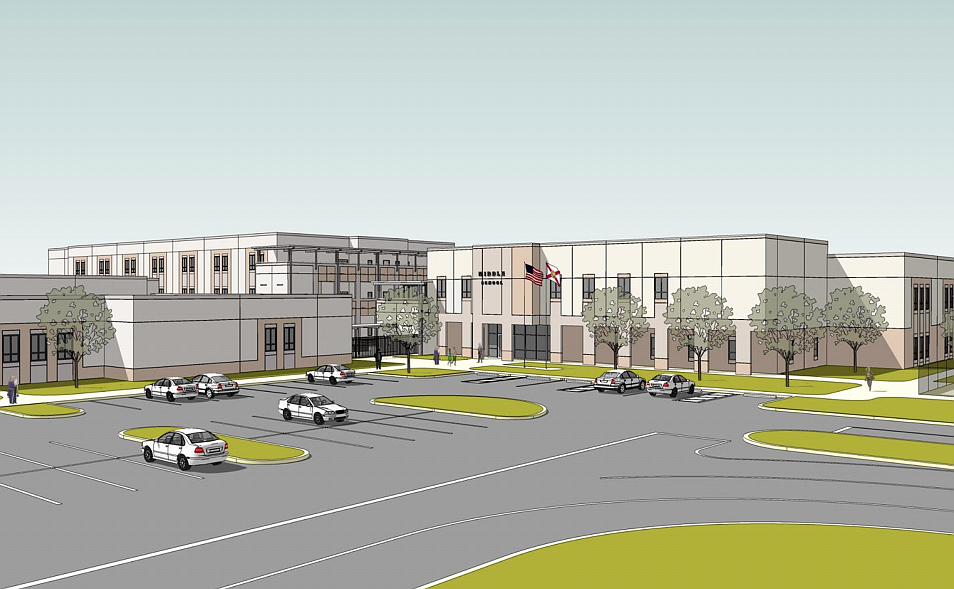- October 23, 2024
-
-
Loading

Loading

ORANGE COUNTY As the fourth-largest school district in Florida — and the ninth largest in the country — Orange County Public Schools is no stranger to accommodating a growing student population.
However, doing this is no easy feat, and there are no inherently simple solutions.
OCPS already oversees 188 traditional K-12 schools — along with a Capital Improvement Plan that outlines the schedule of renovating, replacing or building new schools over the next 10 years.
As of Dec. 15, more than 207,000 students are currently enrolled at those 191 traditional schools, and the number keeps growing as more families decide to call the Orange County area home.
And the growth isn’t stopping anytime soon, either. According to projected population statistics from the Orange County Planning Division, by 2020, the total population of students — ages 5 to 19 — will have grown by 25% since 2000.
With the ever-increasing volume of students moving to Orange County, reduced availability of suitable land to build schools on, the current funding available and even neighborhood opposition, more than ever, OCPS staff now are faced with the dilemma of how to accommodate the communities they serve as efficiently as possible.
DETERMINING NEED
Before the district can even begin to think about building, renovating or replacing schools, the areas in question must demonstrate a need for it.
And it takes teamwork, too. OCPS’s Department of Facilities Planning is responsible for ongoing coordination with Orange County and its member governments.
There is a multitude of factors that must be considered when determining effective solutions for the county’s schools, and this includes coordination of the following: gathering information on growth and development; implementation of interlocal agreements; negotiating capacity enhancement agreements and school concurrency agreements; securing land entitlements for new schools; and coordinating planning activities with other OCPS departments.
Gathering information on growth and development is the first step, especially in OCPS’ fast-growing District 4, which covers much of west and southwest Orange County. By 2022, District 4 will have gained three relief elementary schools, a middle school and a high school in the span of four years.
But the need is not exclusive to the west side of the county. Since 2003, OCPS has sited, built and opened 49 new schools to accommodate growth and relieve overcrowding. And through the 2017-18 school year, an additional 108 existing schools will have been replaced or renovated.
According to OCPS, the district is also involved in reviewing residential development applications. This is to assess the availability of school capacity for projects seeking a future land-use map amendment or rezoning that increases residential density.
As part of its Capacity Enhancement review process, the district looks to mitigate the overcrowding issue at schools past capacity, especially if they would be affected by additional units created by a future land-use change or rezoning.
PROBLEM-SOLVING PROCESS
Once a need has been determined, it’s time to find a suitable location for a new school. Projects must also be prioritized depending on the areas with the greatest needs. Sometimes a relief school might not be needed, but an older facility is due for upgrades, renovations or even a total replacement.
And, the district said, there is no cutoff rate or formula alone that determines when a school will be relieved.
New schools are scheduled to open when enrollment is sufficient to support an additional school. Schools needing relief could be temporarily overcrowded while new schools are designed and built.
All plans to accommodate growth are detailed in a 10-year Capital Improvement Plan, which is updated annually. However, although the need for relief at schools such as Bridgewater Middle — currently at 200% capacity — might be apparent, there still are limited fiscal resources.
“With the volume of students coming in to OCPS each year, it is literally not possible to build schools that quickly based on current funding,” said OCPS spokeswoman Lauren Roth. “We opened 13 new or rebuilt schools this year and have 11 next year, which makes our program the most aggressive school-building program in the country. But (because) some of those are rebuilds/renovations of existing schools, they don’t all add capacity.”
Primary fiscal resources include the half-penny sales tax, property taxes and impact fees. Sales taxes pay for school renovations, while impact fees pay for new schools. Relief-school openings must also be timed to ensure the school doesn’t open half empty, resulting in operational inefficiencies.
Schools aren’t cheap, either. An elementary school prototype includes 830 student stations and costs $20 million. Middle schools include 1,215 student stations and cost between $35 and $40 million. High schools, which can accommodate 2,776 students, cost $90 million.
Additionally, finding suitable land on which to build new schools is becoming more of a challenge as development countywide continues. Roth said that demographic projections are used to identify a target area where a school site will be needed, and the OCPS Real Estate Management team looks for available sites in the area.
Potential sites must meet state and local regulations, and many factors are taken into account: minimum size requirement, cost, whether land is flat and dry, lot shape and size, connectivity to infrastructure, compatibility, opportunities for joint use and future land use and zoning.
“The school district has an obligation to all of our communities — both growing and established — to make sure students are in modern, well-equipped facilities,” Roth said. “So that means we need to both rebuild existing schools that are aging and build new schools to accommodate growth at the same time.”